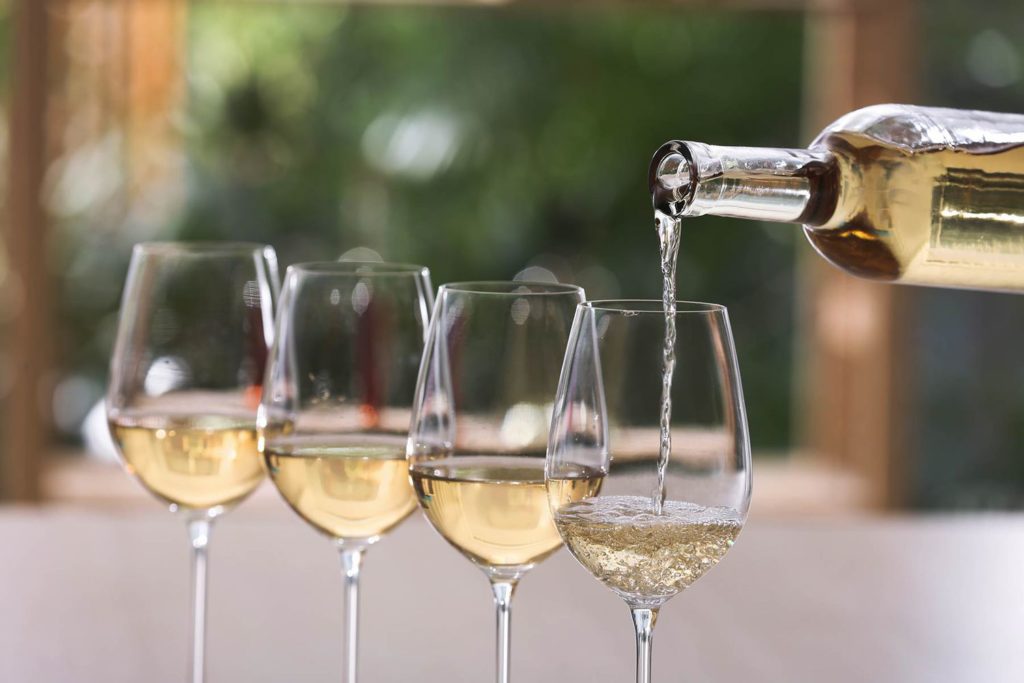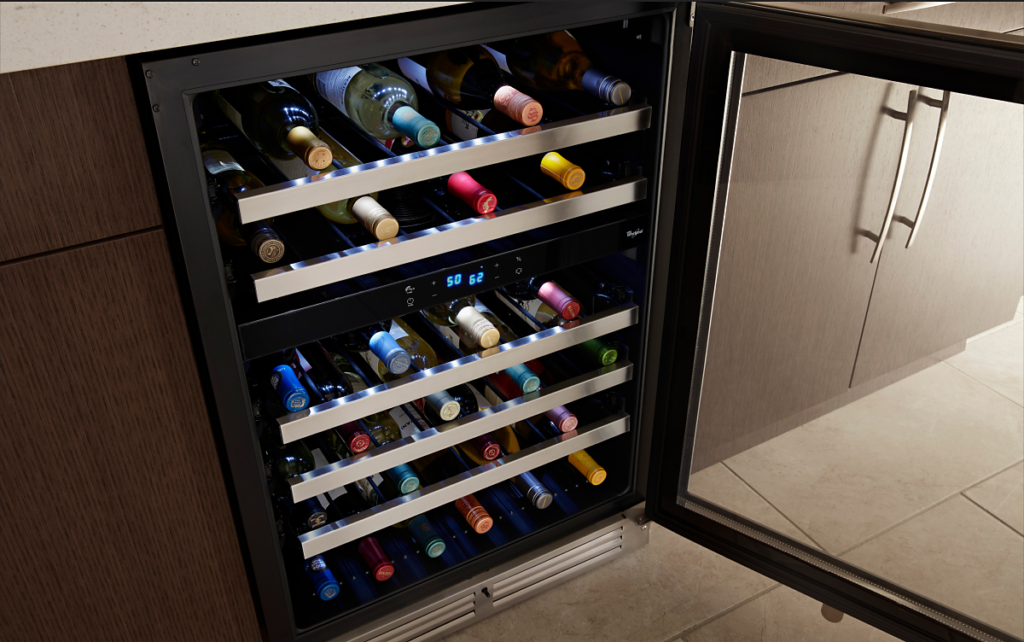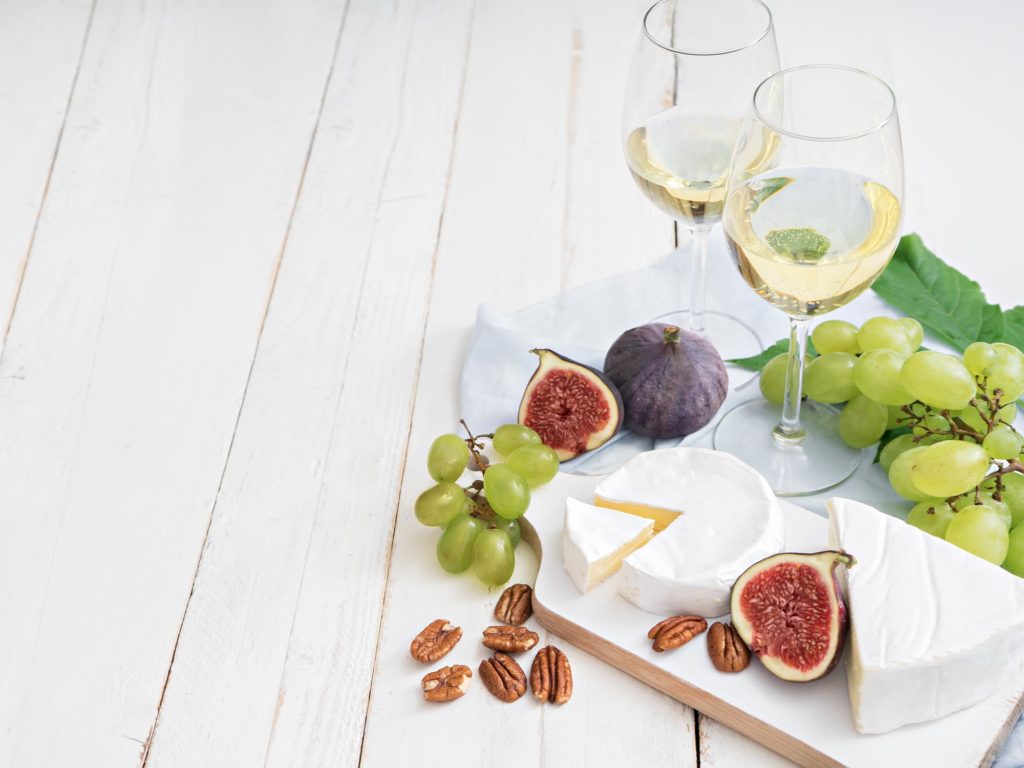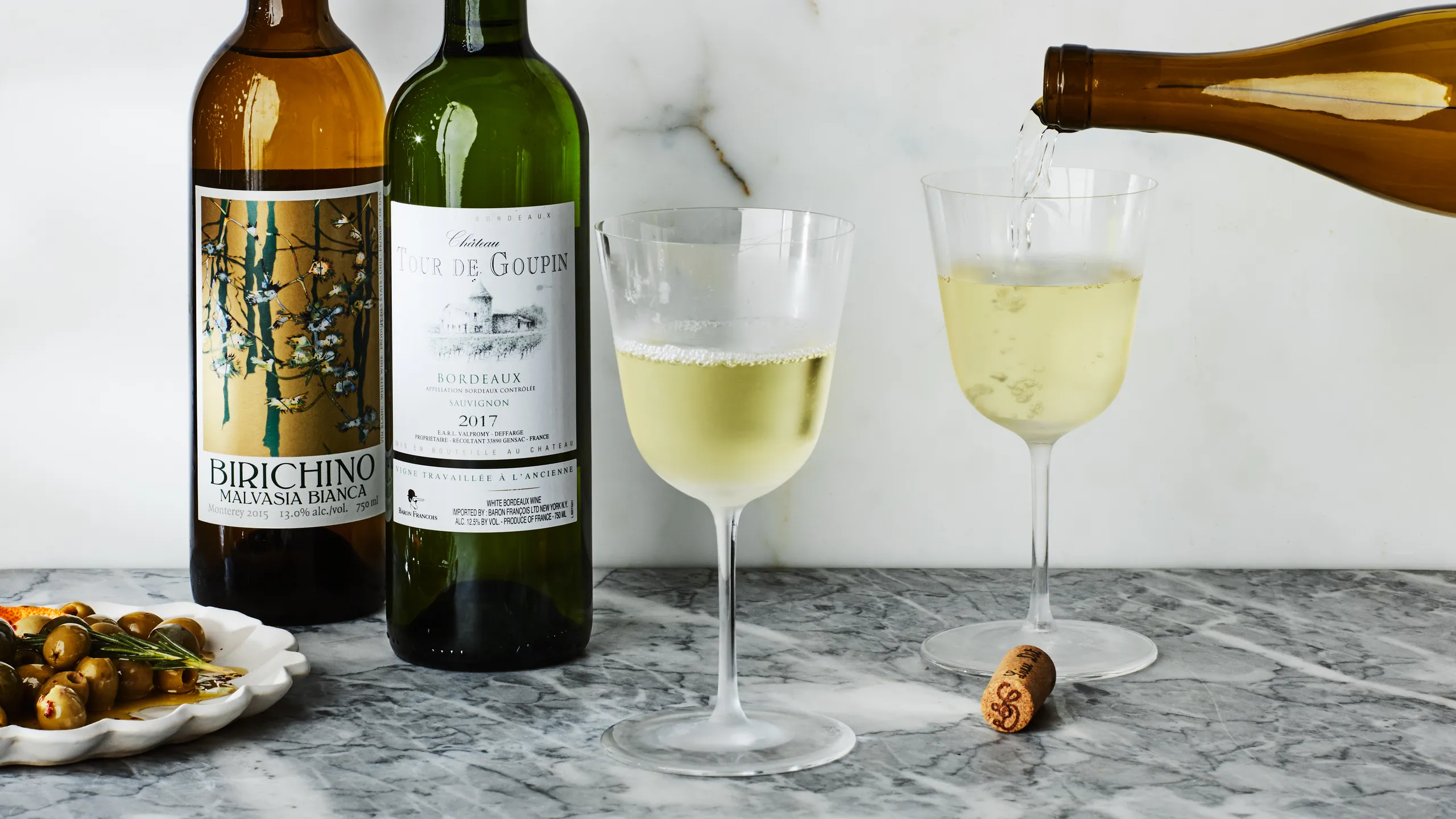White wine is favored by many since it may be utilized in a variety of situations. “Does white wine need to be refrigerated?” is one of the common inquiries. To ensure that white wine is served and preserved in good condition, read this article.
1. An Overview of White Wine Storage
You probably already know that there are proper and improper techniques to preserve wine if you are looking into and purchasing good white wine. White wine can maintain its flavor and aroma by being chilled properly.
But making the wrong decision could permanently harm the white wine. For the most thorough explanation of the question “Does white wine need to be refrigerated?”, read this post attentively.
2. Does White Wine Need To Be Refrigerated?

For a few months, maybe even years, it will stay reasonably well in the bottle. If the bottle has a cork, make sure to set it on its side so that the cork stays moist.
Remember that, when kept in storage for a long time, few white wines can last as long as red wines. Most white wines shouldn’t be stored in your cellar for an extended amount of time.
Once it has been opened, it is best to keep it in the refrigerator with a cover or stopper. It will be alright for a few days like this. White wine should be kept in the refrigerator to maintain its quality and protect it from outside influences.
Wine oxidation, for instance, can cause the wine to degrade sooner and has several negative consequences on the wine’s quality. White wine must therefore be kept in the refrigerator after opening as both a necessity and a means to save money.
Additionally, cooling a white wine improves the absorption of its acidic qualities and gives it a vivid scent. Although flavors and alcohol content are interestingly combined at colder temperatures, too much coldness might make the beverage seem random and unappetizing rather than like a tasty delight.
You can see more:
- Merlot vs Cabernet Sauvignon: Explore the Key Differences
- Does Chardonnay Go Bad? Expert Advice for Wine Storage
- How Is Cabernet Sauvignon Served? All You Need To Know
3. Best Temperatures For Storing White Wine
When storing wine, you should take into account whether you plan to keep it for an extended period or just a short while. Long-term wine storage typically extends the shelf life of wine beyond six months, while short-term wine storage typically has a shorter shelf life.

SPATIAL WINE STORAGE
The likelihood is that you will serve your wine soon if you intend to preserve it for less than six months. While it’s acceptable to keep your white wine at one temperature for storage, each white wine will have a preferred serving temperature.
Each wine should be stored at the ideal serving temperature if you want to bring out the proper tastes and aromas and if you want the wine to taste as nice as it should.
Prosecco and Champagne, two sparkling wines, are often served at colder temps 3–7°C (37– 45℉). Compared to other wines, they should be cooled more to bring out the fruity tastes and aromas.
While slightly warmer than sparkling wines, lighter wines like Pinot Grigio or Sauvignon Blanc are likewise best served chilled. Off-white is often served best between 7–10°C(45– 50℉). However, you should keep white wine bottles with more oak or body at a little warmer temperature, ideally between 10–13°C(50– 55℉).
To bring out the rich, buttery texture and aromas, thicker white wines like Chardonnay require relatively moderate temperatures, so be careful not to keep the wine in an area that is too warm. If your white wine has a lot of acidity, like Riesling, you should store it at about 7–10°C(45– 50℉).
PROLONGED WINE STORAGE
When storing wine for a long time as opposed to a short time, the recommended storage temperature will vary a little. You should be sure to store wine at the proper temperature whether you’re doing it to preserve it for a long time, as an investment, or simply because you want it to taste better.
It may be argued that long-term wine storage is more crucial than short-term wine storage since wine can age poorly and develop an unpleasant taste if it is kept at an improper temperature for a lengthy period.
Your wine may also be in danger of freezing, which can make it taste flat and increase the likelihood of bottle breakage. Many winemakers and experts agree that red wines should be stored at a temperature between 11°C-14°C(52– 57℉) for long-term white wine storage.
4. Best Temperatures For Serving White Wine
The temperature of the glass or bottle of wine when it is poured is the wine’s serving temperature. The ideal wine serving temperature promotes the free movement of wine molecules, which are responsible for the taste, color, and scent that humans perceive.
A serving temperature that is too high will cause the alcohol to lose its structure, allowing the stable molecules of ethanol to take control. You’ll detect a more boozy, harsh flavor.
Most of the flavor and aroma of wine will be lost when served too cold. The ideal temperature can enhance flavor and let you fully appreciate the wine’s alcoholic content.
For full-bodied wines, the ideal serving temperature for white wine is between 9–15°C (48– 60 °F).
Light and medium white wines, as well as sparkling wines, should be served at a temperature of 6–10°C (43– 50 °F).
White wine will cool by around 1°F every three minutes if chilled in a regular freezer or freezer.
5. How To Recognize If Your White Wine Has Been Ruined?
White wine has a two-year shelf life while unopened, but just 3 to 5 days once opened.
However, a variety of conditions can affect how long it can last.
Here are some warning indications that your white wine bottle has spoiled, which can happen if you don’t store it properly.
5.1. A modification of color
A translucent bottle of white wine may burn and turn dark yellow if left alone for a long period. Younger wines have more vigor, which they lack.
Although some wines are created in this manner, the majority of white wines are bottled in clear glass and are meant to be consumed quickly.
5.2. Balloon
You might notice little bubbles in your wine. This is a sign that the winemaker has not thoroughly fermented the wine or that the sterile wine has not been filtered.
To accentuate their aromatic fruit, some white wines, including Moscato d’Asti and New Zealand Sauvignon Blanc, have a little froth, while Chardonnay shouldn’t have any air bubbles. It is safe to sip wine that has been lightly peppered, although you might not enjoy the flavor.
5.3. Either acetic acid or vinegar
Vinegar will eventually replace all wines. Bacteria are to blame. Vinegar, odors, or even pickles or sauerkraut, are all indicators that your whites are starting to turn brown.
6. Tips for Storing Refrigerated White Wine
It’s crucial to store wine bottles properly to ensure that they are always of high quality. Here are some things to keep in mind when it comes to white wine preservation.

6.1. Defend wine against vibration and light
Whether you plan to store your wine for months or just a few days, keep it as dark as you can. Because wine’s tastes and fragrances can be harmed by direct sunlight’s UV rays.
Alcohol should also be kept away from vibrating equipment like your stereo system, your gym, and your washer and dryer. Wines can age nicely, but vibrations that loosen sediments in the bottle might upset the delicate process.
6.2. Put your wine bottles in a horizontal line
Make careful to place your wine horizontally in a rack designed for corked bottles. Keeping wine on its side helps keep the cork moist, which is necessary for long-term preservation because a dried-out cork can induce seepage and early aging.
Screw-top wine bottles don’t necessarily need to be kept on their sides; horizontal storage is an effective way to store your wines for maximum space and easy access.
6.3. Maintain the ideal humidity for wine.
Between 60 and 68% is the recommended humidity range for a wine cellar. High humidity levels in the wine cellar or storage area may reduce the amount of time your wine stays fresh.
Lower humidity may result in your corks drying out and exposing your wine to the effects of oxygen, while higher humidity may cause labels to peel off the bottles, making them more difficult to exhibit or sell.
6.4. Instead of storing wine in a conventional refrigerator, use a wine fridge
Wine refrigerators, also known as wine coolers, are a great alternative if you don’t have the means to keep your wine consistently cool, dark, and moist.
Wine refrigerators hold wine at the right humidity level and between 50 and 60°F (10 to 15°C), in contrast to regular refrigerators, which keep food extremely cold and dry.
Keeping your wine in a separate wine refrigerator can also help to reduce the possibility of cross-contamination with food flavorings.
7. Foods to Pair With Refrigerated White Wine

Veggies and fruits
White wines pair well with both fruits and vegetables. Green beans or asparagus go well with a crisp white wine like Riesling.
When eating fruity meals, such as those that contain melon or almonds, choose Viognier or Chenin Blanc.
Seafood and fish
White wines go nicely with fish and seafood, as is generally known. This is because the acidity of white wines helps to counteract the heaviness of these foods.
Salmon or tilapia are delicate fish that pairs well with a lighter white wine, such as Sauvignon Blanc. A richer white wine, like Chardonnay, will work for more delectable seafood selections, like lobster or crab.
Dairy and cheese
With cheese and other dairy foods, white wine may be a wonderful mate. Rich Chardonnay pairs well with Brie or Camembert on the cheese board, while Sauvignon Blanc, which is crisper, can liven up dishes that include goat cheese.
8. Alternatives to Regular Refrigeration
Here are a few straightforward methods that will help you enjoy great chilled bottles of wine in addition to using the refrigerator to chill your wine.
8.1. The Cooling Spout
A gadget called a wine chilling spout is one that you freeze before inserting it into the aperture of your wine bottle. Every time it is used, the metal rod inside freezes to a freezing temperature, producing chilled pours.
Although they won’t usually help to chill a heated bottle of wine, these cooling spouts will assist keep your wine chilled with every pour.
8.2. Wine Bag with Insulation
An insulated wine bag may assist the wine bottle keep temperature, just like a koozie does with a can. These bags keep your wine refrigerated for a couple of hours and are reasonably priced.
These insulated wine bags will maintain your bottle of wine cool until the very last drop throughout the time as you’re drinking normally. They won’t, however, help a warm bottle of wine cool off or keep it chilled for very long.
8.3. Ice Bucket or Cooler
Placing beverages in a fridge or cooler is one of the easiest methods to keep them cold during the heat. The best thing to do when taking a bottle of wine out is to place it in a bucket and fill it with ice. This will guarantee that the beverage is excellent and cold each time you return to the bottle to refill it.
If you’ve already refrigerated the bottle, the cooler will perform an excellent job of maintaining the bottle’s temperature for a brief period even without ice.
8.4. Wine Chiller Bucket
Utilizing a wine chiller bucket is another option to assist in keeping your wine chilled. Instead of using ice to keep the wine cold, these buckets are often made to exude colder temperatures from the wine bottle itself.
There are wine chiller buckets that come with an ice pack that fits in the middle; by freezing the ice pack and putting it in the bucket, the bucket may keep the wine cooler for an extended period.
9. Further Reading
9.1. Best storing temperatures for storing red wine
It’s best to keep red wine between 13 and 18°C (55-65℉). Wine storage temperatures should never rise over 24°C (75℉) since doing so causes oxidation, which harms the wine.
9.2. Best storing temperatures for storing sparkling wine and beer, etc
Because the cork will be too wet and enable oxygen to enter, causing the wine to bubble and deteriorate, sparkling wines should be stored upright. In either scenario and fact for any wine, you want to preserve them at 13°C (55˚F) or lower in a dark, temperature-controlled environment.
Keep the bottle at a consistent temperature between 10-13°C (50 and 55˚F) to avoid flavor loss and guarantee your beer tastes as wonderful as it should.
9.3. The ideal temperature to serve red wine
The ideal serving temperature for most red wines is between 13 and 18°C (55 and 65 °F) to keep the desired flavor. When drinking wine, the alcohol flavor may sting slightly if it is too warm, but the tannins may dominate the flavor if it is too cold.
9.4. Best temperatures for serving sparkling wine and beer, etc.
Sparkling wine should be served in thin flute-shaped glasses after being completely chilled for either 30 minutes on ice or 3 hours in the refrigerator. Sparkling wine’s flavor, froth, and aroma are improved by chilling it and serving it between 6-8°C (43°F and 47°F).
Most beers should be served at 3-13°C (38 to 55˚F). Ales are served warmer than light beers. Warmer service is given to stronger beers than to weaker brews. Lighter beers are served colder than dark beers.
10. FAQs
Q: Can you store white wine at room temperature?
While leaving the whites outside is acceptable as long as the bottles are not stored in direct sunshine, the ideal location to store them is in a closet or inside a box where they won’t be disturbed or exposed to light. In particular, the storage space shouldn’t be too warm because this can speed up the wine’s degeneration.
Q: Is a wine refrigerator as cold as a standard refrigerator?
Because wine requires a different storage temperature than other commodities. Additionally, it might cause a white wine smell when combined with food, which can make your experience unpleasant. So, compared to refrigerators or beverage refrigerators, wine refrigerators are set to a higher temperature range. A wine cooler won’t often offer temps below 8°C (46°F).
Q: What occurs if wine is not refrigerated?
After that initial exposure, certain wines will become more expressive, but all wines will eventually lose their intensity. Any flavors of fresh fruit will ultimately fade and the aromatics will flatten out due to oxygen. You won’t become sick from drinking wine that has oxidized and faded; it will only taste bad.
Q: What temperature does white wine start to go bad?
White wine gets ruined by heat. The flavor of wine can be permanently changed by prolonged exposure to temperatures exceeding 21°C (70°F). When the temperature exceeds 27°C (80°F), the wine virtually begins to boil. Wine heat is harmed by its disagreeable sour and jammy flavor.
Q: Which is preferable, storing white wine too hot or too cold?
Undoubtedly, the excessive heat will have an impact on the white wine. It makes the wine taste excessively sour or has an odd odor.
One thing to bear in mind, though, is that when the wine is exposed to cold, it expands and puts pressure on the cork and the bottle wall. In addition, the alcohol will freeze and crystallize at -9 to -6°C (15-20°F). As a result, the bottle may shatter or the stopper may pop, which both result in oxidation.
Q: What distinguishes a wine refrigerator from a regular refrigerator?
The humidity inside a wine refrigerator is kept at a level that keeps corks moist and impermeable. On the other hand, conventional refrigerators are made to reduce humidity, which shrinks corks and allows nearby aromas to seep into wine and overwhelm its inherent flavors.
Q: Can you keep drinks in a wine cooler?
For chilling bottled water, juice, energy drinks, lemonade, soda, sparkling water, and even other alcoholic beverages like beer and wine coolers, a wine fridge is ideal.
11. Conclusion
We think you now know “Does white wine need to be refrigerated?” after reading this comprehensive essay. White wine must be refrigerated if you want to have wonderful dinners with it with your family. We hope that this article has expanded your knowledge of how to store and serve delicious white wine.

With over a decade of experience in viticulture, Simon Conner is the perfect writer to help you find and maintain your prized vintages. As an expert on food, wine, and kitchen products, he offers his expertise to guide clients through every step involved with collecting and selling wines.

